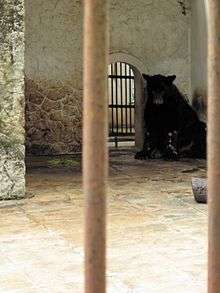Surabaya Zoo
|
Surabaya Zoo | |
| Date opened | April 1918[1] |
|---|---|
| Location | Jalan Setail 1, Surabaya, East Java, Indonesia |
| Coordinates | 7°17′45″S 112°44′10″E / 7.29583°S 112.73611°ECoordinates: 7°17′45″S 112°44′10″E / 7.29583°S 112.73611°E |
| Land area | 15 ha (37 acres) |
| Number of animals | almost 3,500 (2014) |
| Number of species | almost 200 (2014) |
| Website |
www |
Surabaya Zoo (Indonesian Kebon Binatang Surabaya or KBS), also known as Bonbin (abbreviation of Kebon Binatang, Indonesian for "zoo"), is a 15-hectare (37-acre) zoo located in the city of Surabaya in East Java, Indonesia.
History

Surabaya Zoo was established by decree of the Governor General of the Netherlands East Indies on 31 Agustus 1916 as Soerabaiasche Planten-en Dierentuin on the merit of the journalist H. F. K. Kommer who had the hobby of collecting animals.[2]
In 1916, the first Surabaya Zoo was established in Kaliondo. On 28 September 1917, the zoo was moved to Groedo road. In April 1918, Surabaya Zoo sold tickets to enter the zoo.[2]
In 1920, the zoo was transferred to another new location in Darmo area, on a plot of land measuring 30,500 m2 belonged to the Oost-Java Stoomtram Maatschappij (steam tramway company of East Java). On 21 July 1922, the zoo experienced its first financial crisis and there was a plan to disestablish the zoo, but the decision was not agreed by the Surabaya municipality at that time. On 11 May 1923, it was decided to establish a new association for the zoo. W. A. Hompes was chosen to replace J.P. Mooyman, one of the early founder of the zoo. In 1927, the zoo was financially aided by the mayor of Surabaya, Dijkerman. With the help of People's Representative Council of Surabaya, on 3 July 1927 a new plot of land was bought for Surabaya Zoo, measuring 32,000 m2, from a plot of land owned by steam tramway company of East Java.[2]
From 1939 until now, the size of the zoo has expanded to 15 hectares.[2]
In August–November 1987 the breeding facility in Surabaya Zoo was renovated. This facility comprised 29 aviaries with 16 endangered Bali starlings, found only in the western part of Bali island. In November 1987, the captive population was increased with the addition of 37 birds donated by zoos and private collections in the USA and by Jersey Wildlife Preservation Trust.[3] The success of the breeding program of the Bali starling at this zoo allowed the release of 40 starlings into the wild at West Bali National Park in June 2011.[4]
Animal death crisis

The Surabaya Zoo has received complaints about its treatment of animals from activist groups such as the Jakarta Animal Aid Network (JAAN), as well as from the interim administrator of the zoo.[5] The situation reached a point in 2010 where The Jakarta Post called the facility the 'Surabaya Zoo of Death'[6] In August, 2010, the Forestry Ministry revoked Surabaya Zoo’s license following several animal deaths, including, a rare Sumatran tiger, African lion, wallaby, Komodo dragon, babirusa, Bawean deer, and crocodile.[7][8] Interim management asked the local police and the East Java Natural Resources Conservation Agency (BKSDA) to conduct an investigation, which found that negligent keepers were to blame for most of the animal deaths.[9] The Temporary Management Team transferred 378 animals from the zoo to 6 conservation organizations.[10] However, several of the animals were in severe conditions, and eventually died. An autopsy performed on the animals found plastics and wood among the dead animals.[11]
On 28 January 2014 Surabaya Zoo authority announced that the zoo has a collection of 3,459 animals from 197 species, but 81 animals are sick, disabled, and old, and 44 of which are in severe conditions.[12][13]
Komodo dragon park
As of April 2015, Surabaya Zoo had 70 Komodo dragons of which 13 were less than a year old, with more expected after the laying of a dozen eggs a few months earlier. To deal with the likely overpopulation, the Surabaya authority has planned to build a dragon park in Kenjeran coastal area, this being less expensive than attempting to release the dragons into the wild.[14]
References
- ↑ "Surabaya Zoo". surabaya.go.id. City of Surabaya. Retrieved 31 December 2010.
- 1 2 3 4 "Kebun Binatang Surabaya". Surabaya.go.id (in Indonesian). Surabaya City Government. Retrieved 24 May 2014.
- ↑ Olney, P.J. (1994). Creative Conservation: Interactive Management of Wild and Captive Animals. Springer. p. 422. ISBN 9780412495700.
- ↑ Warta (18 June 2011). "Surabaya zoo releases 40 endangered birds into Bali national park". waspada.co.id. Waspada Online. Retrieved 24 September 2011.
- ↑ "Zoo official issues dire warning about the treatment of animals at Indonesia's Surabaya Zoo". Los Angeles Times. 18 August 2010.
- ↑ "More Animals in Critical Condition at Surabaya’s Alleged Zoo of Death". Jakarta Post. 19 August 2010.
- ↑ "Gibbon Latest Victim as Surabaya Zoo Death Toll Continues to Climb". Bataviase. 25 September 2010.
- ↑ "Govt sets up team to temporarily manage Surabaya zoo". Waspada Online. 21 August 2010.
- ↑ "Zoo Suspects Missing Komodo Dragons Either Eaten or Stolen". Jakarta Post. 23 March 2011.
- ↑ David Priya Sidharta (18 January 2014). "KBS Sends 387 Animals to 6 Conservation Organizations".
- ↑ David Priya Sidharta (21 January 2014). "Sebagian Satwa Limpahan Kebun Binatang Surabaya Mati".
- ↑ Zainal Effendi (28 January 2014). "Ada 84 Satwa KBS yang Tua dan Cacat".
- ↑ Tejo, Amir. "Two Animals Dead in a Day at Surabaya Zoo". Jakarta Globe.
- ↑ "Surabaya to Build Komodo Dragon Park". April 11, 2015.
External links
| Wikimedia Commons has media related to Surabaya Zoo. |
- (English) About Kebun Binatang Surabaya
- (Indonesian) Tentang Kebun Binatang Surabaya
- (Indonesian) Prahara Kebun Binatang Surabaya
- (English) Facebook Page : Shutdown Surabaya Zoo[The Zoo of Death]
- (English) The Telegraph[UK] gallery : Surabaya Zoo: animals kept in scandalous conditions at Indonesia's largest zoo
| ||||||